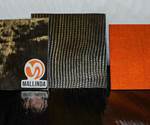ORNL develops recyclable polymer for low-carbon composites manufacture
Novel vitrimer polymer prevails over the intrinsic limitations of conventional epoxy vitrimers, driving net-zero goals forward.
Researchers at Oak Ridge National Laboratory (ORNL) designed a recyclable carbon fiber material to promote low-carbon manufacturing. Photo Credit: Chad Malone/ORNL, U.S. Department of Energy (DOE)
Oak Ridge National Laboratory (ORNL, Knoxville, Tenn., U.S.) scientists have designed a recyclable polymer for carbon fiber composites to enable circular manufacturing of parts that boost energy efficiency in automotive, wind power and aerospace applications.
“Our goal is to extend the lifecycle of these materials by making reuse possible without sacrificing performance,” Anisur Rahman, managing director, ORNL, says.
The team’s approach incorporates vitrimers, a class of plastics derived from thermosetting polymers that consist of molecular, covalent networks that can change their topology via thermally activated bond-exchange reactions. These dynamic, reversible bonds have enabled carbon fiber and polymer recycling as a result of their reprocessability. However, according to ORNL, reprocessing mechanically robust vitrimers, such as epoxy vitrimers, typically requires high temperatures and long processing times, which cause degradation and compromise efficient recyclability.
To overcome this, the team designed polyurea/epoxy (DPE) vitrimers and their carbon fiber-reinforced polymer (CFRP) counterparts with exchangeable disulfide cross-links, which reportedly prevailed over several intrinsic limitations. Compared with conventional epoxy vitrimers, the new polymer exhibited a six times faster bond rearrangement and ∼40°C lower reprocessing temperature, enabling it to maintain mechanical strength in six reprocessing cycles, a sharp contrast to previously reported polymers. Conversely, conventional vitrimers lost ∼63% of their strength. Moreover, the CFRPs prepared with the DPE vitrimers showed facile multi-cycle processability and repairability by thermoformation.
“ORNL’s carbon fiber composites enable fast processing and can be repaired or reprocessed multiple times, opening pathways to circular, low-carbon manufacturing,” ORNL’s Tomonori Saito adds.
For the complete study, see “Unraveling a path for multi-cycle recycling of tailored fiber-reinforced vitrimer composites.”
Related Content
-
The potential for thermoplastic composite nacelles
Collins Aerospace draws on global team, decades of experience to demonstrate large, curved AFP and welded structures for the next generation of aircraft.
-
TU Munich develops cuboidal conformable tanks using carbon fiber composites for increased hydrogen storage
Flat tank enabling standard platform for BEV and FCEV uses thermoplastic and thermoset composites, overwrapped skeleton design in pursuit of 25% more H2 storage.
-
Combining multifunctional thermoplastic composites, additive manufacturing for next-gen airframe structures
The DOMMINIO project combines AFP with 3D printed gyroid cores, embedded SHM sensors and smart materials for induction-driven disassembly of parts at end of life.

















